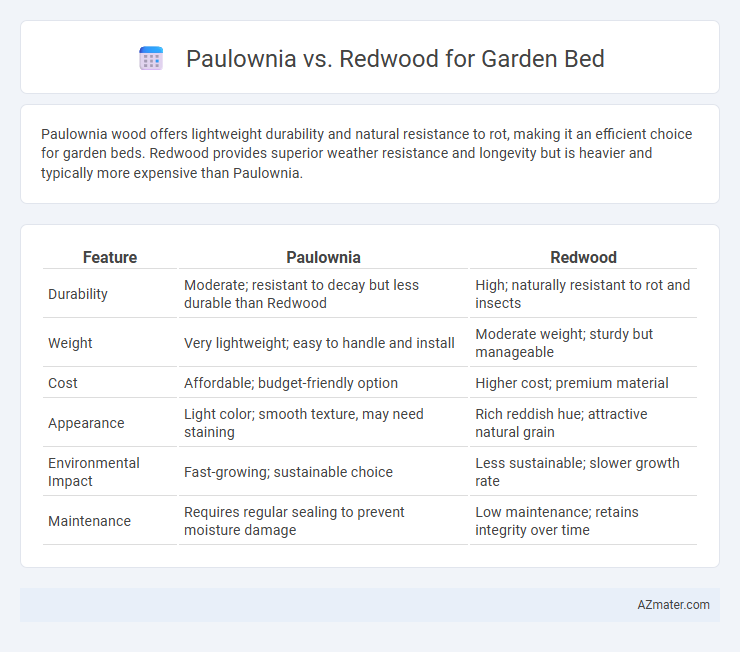Paulownia wood offers lightweight durability and natural resistance to rot, making it an efficient choice for garden beds. Redwood provides superior weather resistance and longevity but is heavier and typically more expensive than Paulownia.
Table of Comparison
| Feature | Paulownia | Redwood |
|---|---|---|
| Durability | Moderate; resistant to decay but less durable than Redwood | High; naturally resistant to rot and insects |
| Weight | Very lightweight; easy to handle and install | Moderate weight; sturdy but manageable |
| Cost | Affordable; budget-friendly option | Higher cost; premium material |
| Appearance | Light color; smooth texture, may need staining | Rich reddish hue; attractive natural grain |
| Environmental Impact | Fast-growing; sustainable choice | Less sustainable; slower growth rate |
| Maintenance | Requires regular sealing to prevent moisture damage | Low maintenance; retains integrity over time |
Introduction to Paulownia and Redwood for Garden Beds
Paulownia and Redwood are popular choices for garden beds due to their durability and natural resistance to decay. Paulownia, known for its fast growth and lightweight yet strong wood, offers excellent moisture resistance, making it ideal for raised garden beds exposed to varying weather conditions. Redwood provides natural tannins that protect against insects and rot, ensuring long-lasting garden structures with a rich reddish hue that enhances aesthetic appeal.
Wood Durability: Paulownia vs Redwood
Paulownia wood offers moderate durability with natural resistance to rot and insects, making it suitable for garden beds in mild climates, but it generally has a lower density compared to redwood. Redwood is highly durable due to its natural tannins and oils that provide excellent resistance to decay, insects, and moisture, making it a preferred choice for long-lasting garden beds, especially in humid or wet environments. When prioritizing wood durability for garden beds, redwood outperforms paulownia by maintaining structural integrity and appearance over extended outdoor exposure.
Resistance to Rot and Pests
Paulownia wood exhibits exceptional resistance to rot and pests due to its natural oils and low moisture absorption, making it highly durable for garden beds in humid or wet environments. Redwood is also well-known for its strong resistance to decay and insect damage, attributed to its high tannin content, which helps protect garden beds from fungal infections and wood-boring insects. Both woods offer long-lasting performance, but Paulownia's lighter weight and faster growth rate provide an eco-friendly advantage, while Redwood remains a preferred choice for its rich color and natural preservative properties.
Weight and Ease of Handling
Paulownia wood is significantly lighter than redwood, making it easier to handle and install when building garden beds, especially for DIY projects or frequent relocation. Redwood is denser, providing greater durability but increasing the weight, which can complicate assembly and mobility. For gardeners prioritizing ease of handling and lightweight materials, paulownia offers a practical solution without sacrificing structural integrity.
Sustainability and Environmental Impact
Paulownia wood is highly sustainable due to its rapid growth rate, ability to absorb large amounts of CO2, and minimal resource requirements, making it an eco-friendly choice for garden beds. Redwood, while naturally resistant to decay and pests, grows much slower and is often harvested from old-growth forests, raising concerns about deforestation and habitat loss. Choosing paulownia over redwood significantly reduces environmental impact by promoting renewable forestry and lowering carbon footprints in garden bed construction.
Cost Comparison: Paulownia vs Redwood
Paulownia wood is generally more cost-effective than redwood, offering a lower price point per board foot while maintaining lightweight durability suitable for garden beds. Redwood tends to be more expensive due to its natural resistance to decay and insect damage, which can reduce long-term maintenance costs despite the initial higher investment. When balancing upfront cost versus longevity, paulownia provides an affordable option for budget-conscious gardeners, whereas redwood may deliver greater value through extended lifespan and minimal upkeep.
Aesthetic Appeal and Color Retention
Paulownia offers a light, honey-toned hue that ages gracefully to a soft silver-gray, maintaining a consistent, natural aesthetic ideal for gardens seeking a warm and modern look. Redwood boasts deep reddish-brown hues that retain vibrancy longer due to natural tannins, providing a classic, rich color that adds timeless elegance to garden beds. Both woods resist fading but Redwood generally holds its color intensity better over time, making it preferred for sustained visual impact in outdoor landscapes.
Maintenance Requirements
Paulownia garden beds require minimal maintenance due to their natural resistance to rot and insects, making them ideal for low-effort gardening. Redwood also offers excellent durability and decay resistance but may need occasional sealing or treatment to maintain its appearance and structural integrity. Both woods provide longevity in outdoor settings, yet Paulownia's lightweight nature further simplifies upkeep compared to the denser Redwood.
Safety for Edible Gardening
Paulownia wood is non-toxic and naturally resistant to pests and decay, making it a safer choice for edible garden beds where chemical leaching must be avoided. Redwood also offers durability and resistance to rot but may contain natural tannins that can affect soil pH and potentially influence plant growth. Choosing untreated Paulownia ensures minimal impact on edible crops, prioritizing food safety and sustainable gardening practices.
Final Recommendation: Which Wood is Best for Your Garden Bed?
Paulownia offers fast growth, lightweight durability, and natural resistance to pests, making it ideal for gardeners seeking sustainable and easy-to-handle materials. Redwood provides superior decay resistance and a rich, natural aesthetic, which suits long-term outdoor garden beds exposed to harsh weather. For most garden bed projects, redwood is the best choice when prioritizing longevity and appearance, while paulownia is preferable for budget-conscious or lightweight structures.

Infographic: Paulownia vs Redwood for Garden Bed
 azmater.com
azmater.com